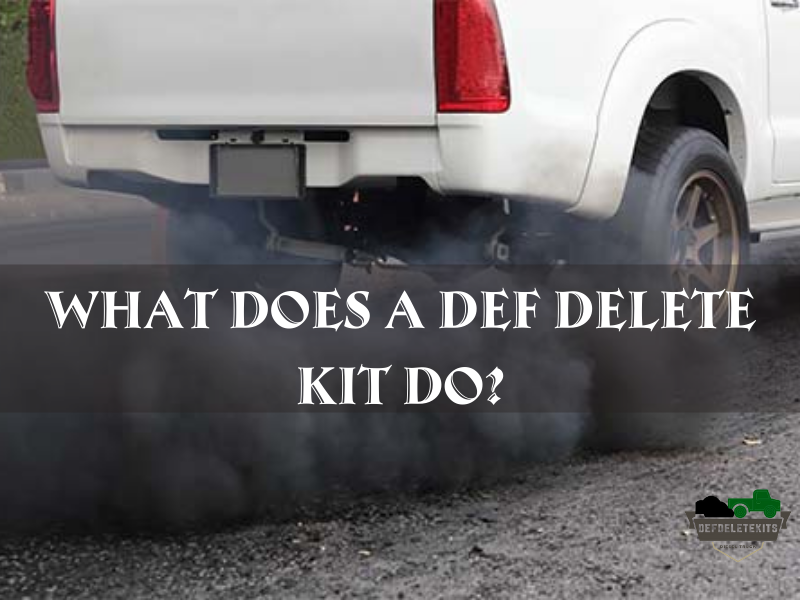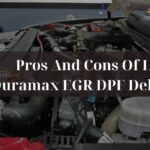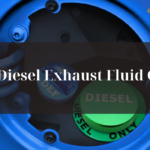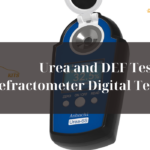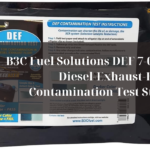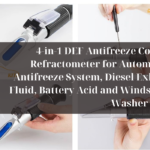What does a DEF delete kit do?
A DEF delete kit is a device that is installed in any kind of diesel vehicle, with the purpose of removing the need to have diesel exhaust fluid (DEF), or urea injection.
Urea is injected into diesel engines to remove oxides of nitrogen (NOX) from the vehicle’s exhaust stream.
The addition of DEF helps keep the inside of a diesel vehicle clean.

Ford, GM, and Ram have been using DEF injection for some time now on their diesel vehicles. Mercedes-Benz has even begun to add it to their BlueTec lineup of diesel cars and trucks, starting from 2009 models.
DEF is inserted into the exhaust stream after the engine where NOX is reduced to nitrogen, water vapor, and carbon dioxide.
It is composed of urea and deionized water in a 32.5% solution which can be injected into a hot exhaust system at temperatures between 300°C and 480°C (572°F – 896°F).
The urea breaks down into ammonia, which reacts with NOX in the system to produce harmless nitrogen, water vapor, and carbon dioxide.
DEF not only helps to reduce the toxic chemicals leaving your vehicle’s tailpipe, it also provides lubrication for engine components that are exposed to high temperatures while helping keep them clean!
A def delete kit removes the need for this injection process completely by removing the urea tank from your diesel vehicle entirely. This means that there is no more need to add DEF which would save you time and money in the long run. However, some diesel vehicles do have problems when def deletion kits are installed. These def delete kits typically increase fuel consumption by about 2 – 3mpg on average depending on driving habits, terrain, etc…
The EPA estimates that def tanks will be required on new diesel truck models starting in 2013.
A def delete kit is an easy solution for you to solve the issue of DEF. There are def delete kits that can be installed on diesel vehicles with or without DPF (diesel particulate filter). A def delete kit comes in two forms, one of which includes a urea tank bypass system and another def delete kit that does not include this feature. If your vehicle has a DPF then it would be wise to purchase a def tank bypass system.
How Do Diesel Emissions Systems Work?
Diesel emissions systems are used in diesel-powered vehicles to reduce or eliminate harmful emissions. These emissions are formed when the fuel, which is made up of long hydrocarbon chains, is cleaned and broken down into carbon dioxide (CO2), water vapor (H2O), and lots of heat.
A def delete kit works by injecting a fluid known as urea into the exhaust stream where it then breaks down harmful chemicals in diesel emissions systems before being released out of the tailpipe. This fluid is stored inside an emission control device called an after treatment system.
Different Types Of Diesel Emissions Systems
There are two different types of diesel emissions systems that include a selective catalytic reduction (SCR) and an oxidation catalytic converter(OCC).
An SCR def delete kit is a def tank that can be filled with urea or diesel exhaust fluid to help reduce harmful emissions by as much as 90% at low temperatures and flow rates. There are two different types of these def delete kits which include injection systems and flow through def tanks.
When you install a def delete kit, your fuel consumption will increase an average of 2 – 3 mpg depending on driving habits, type of terrain, etc…
Injection Systems: Injection def delete kits use a pump to draw the fluid from the storage tank into the vehicle’s exhaust stream where it then breaks down NOX into nitrogen and water vapor. A high-pressure pump sprays the fluid near the engine’s turbocharger initially where the engine has a higher temperature so it works most effectively.
Flow-Through def delete kits: These def delete kits work by using pressure from the exhaust system to push the fluid through a tube into the SCR where it then breaks down NOX into nitrogen and water vapor. A flow def delete kit is typically more affordable than an injection system but only works when there is sufficient flow in the exhaust stream.
An OCC def delete kit is a type of diesel emissions system that uses oxidation catalysts that contain platinum, palladium, and rhodium metals which convert carbon monoxide (CO) and unburned hydrocarbons (UHC) in diesel engines into carbon dioxide (CO2), water vapor (H2O) and heat.
These def delete kits use a catalyst to oxidize or burn harmful emissions. This def delete kit is an exhaust gas recirculation (EGR) valve that sprays the fluid into the engine’s exhaust stream as it flows through the EGR tube similar to spraying a can of WD-40 onto a squeak. The Urea def delete kit contains ammonia which reacts with NOX in the presence of heat and breaks them down into nitrogen and water vapor at different temperatures.
An EGR def delete kit reduces your vehicle’s fuel consumption by improving efficiency and reducing carbon build-up on piston crowns inside the engine. You may notice this improvement from 2 – 4 mpg depending on driving habits, terrain, etc…
What Does It Mean To Delete A Diesel?
To def delete means to drive without the def (diesel particulate filter). A def delete kit comes in two forms, one of which includes a urea tank bypass system and another def delete kit that does not include this feature. If your vehicle has a DPF then it would be wise to purchase a def tank bypass system.
How To Install A Def Delete Kit?
A def tank is usually mounted underneath the vehicle near the spare tire with hoses running forward into the exhaust side along with hoses for injection fluid draining down into the pan below. Some def tanks are located inside the engine bay or behind the rear axle depending on your make and model of car or truck. On newer vehicles, some def delete kits are built directly into the exhaust manifold and def delete lines run all the way back to def tanks.
Once you remove the stock def tank it is recommended that you immediately replace or repair any leaks with a high-temp RTV gasket maker and then test the system by filling the def tank and seeing if it holds fluid without leaking. The next step in installing a def delete kit is attaching your def delete lines to the injection pump, either on top of or below your vehicle’s factory diesel particulate filter (DPF) depending on which type of kit you’re working with. You may need to drill holes into existing ones for mounting purposes.
A properly installed def delete kit comes with new o-rings, washers, brackets, etc… often replacing some stock items with def delete kit hardware that has been pre-welded or machined. Some def delete kits include a def tank but most def delete kits you purchase will require you to purchase your own def tank which is usually mounted in the same location as the stock def tank.
Driving Def Delete Kit
Once installed and filled with diesel exhaust fluid (DEF), driving around on a def delete kit alone won’t clean emissions and may result in engine damage unless you’re running your vehicle in “P” position instead of drive (D). If you’re only installing a def delete kit then we recommend using it when your vehicle is not traveling at speeds over 55 mph for longer than five minutes to ensure DEF reaches operating temperature and stays there long enough to get the def delete kit system working.
The Cold Hard Truth on Truck Emission Deletes and Tune-sUps
Despite the necessity of def delete kits to use with DPF def delete systems, factory trucks are not equipped with DEF injection lines or def tanks because def is required by law in all light-duty diesel vehicles sold in North America. The def delete kit does not reduce pollution enough to be legal unless you’re running your vehicle for longer than 10 minutes at a time or before an emissions inspection.
This means that if you want to run a def delete kit without incurring the risk of engine damage, you’ll need to drive less than 55 mph for more than five minutes at a time which defeats the purpose of installing any part meant for adding power and performance!
Conclusion
Finally, to def delete or not def delete is up to you… it’s a personal decision and there are benefits, either way, depending on where you live and how often you drive your vehicle. If you own a diesel car or truck with a DPF, why not def delete it? It’s all about having the right information before making an informed def delete kit purchase.
